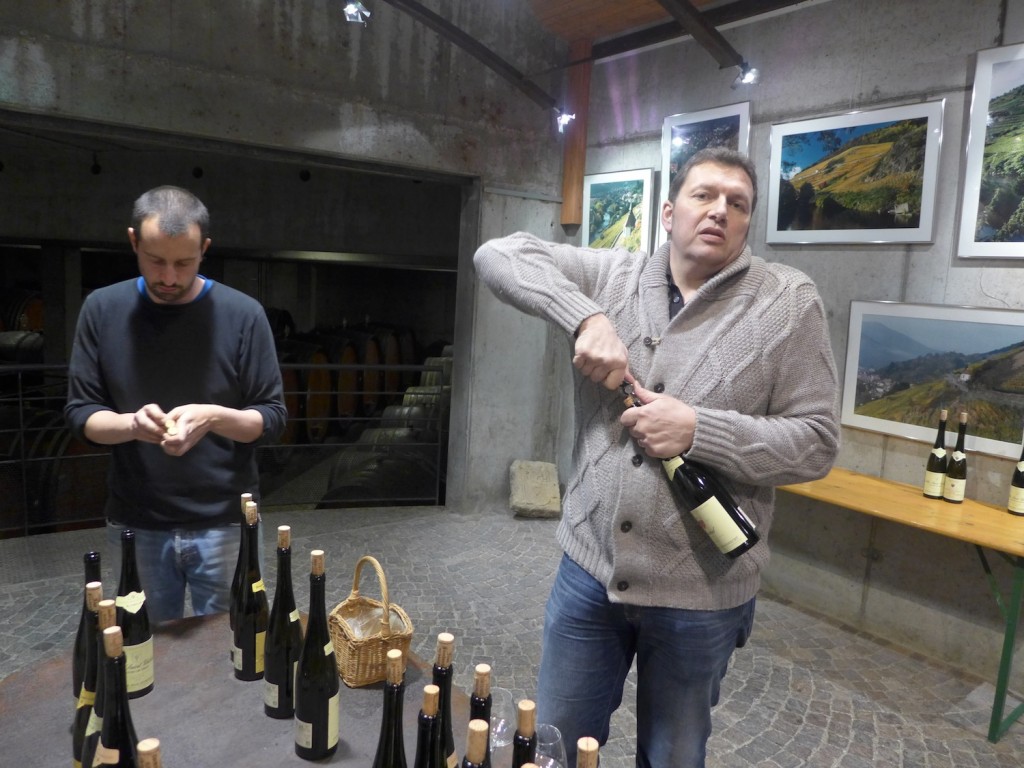 I was sure that I was holding the bottle firmly, but suddenly it hit the stone floor and smashed between my feet in the reception room of Domaine Zind-Humbrecht just outside Turckheim/Alsace. Olivier Humbrecht disappeared for a moment, then reappeared with another bottle of the same wine and pressed into my hands with a smile. I felt seriously humbled by this gesture of generosity, but then I already felt seriously humbled by the wine tasting which had filled the entire afternoon. I first visited Zind-Humbrecht in early 1987 and what I tasted that day changed how I saw Rieslin, hell it changed the way I saw everything! And the same thing had just happened again. How could that be possible?
I was sure that I was holding the bottle firmly, but suddenly it hit the stone floor and smashed between my feet in the reception room of Domaine Zind-Humbrecht just outside Turckheim/Alsace. Olivier Humbrecht disappeared for a moment, then reappeared with another bottle of the same wine and pressed into my hands with a smile. I felt seriously humbled by this gesture of generosity, but then I already felt seriously humbled by the wine tasting which had filled the entire afternoon. I first visited Zind-Humbrecht in early 1987 and what I tasted that day changed how I saw Rieslin, hell it changed the way I saw everything! And the same thing had just happened again. How could that be possible?
I was well aware of the fact that Olivier Humbrecht had not only converted to biodynamic cultivation, but also adopted many unconventional cultivation techniques such as completely abandoning hedging the vines during the growing season (which is no less controversial than biodynamics). However, I was not aware of how all of this fitted together, that is made up entirely new system of winegrowing whose goal is conserving freshness in order that he can continue to use the uncompromising vinfication style which he inherited from his father Léonard and refined during his first years at the domaine a quarter of a century ago. However, this is just an attempt at an explanation for the taste of the wines which cannot be fully explained in any way, even with the assistance of the idea of terroir.
I’d love to tell this story at length, but circumstance is totally against me. My computer refuses to let me onto the hotel wifi and forces me to use the use the clumsy computer in the hotel lobby to file this story. That makes me feel like a war zone correspondent, although all I’m doing is writing about Riesling. And what amazing Rieslings they are! Although they grow in the warmest and one of the driest Riesling winegrowing regions in Europe the Zind-Humbrecht Rireslings are gigantically fresh wines and this freshness is married to an astonishing intensity of expression. Each wine is entirely itself, absolutely original in the way a great work of art is (which is the kind of orginality that defines a great work of art), as dazzlingly bright as a newly born star.
This means it isn’t possible to give a general description of how the Zind-Humbrecht Rieslings taste, except to say that they are usually properly dry wines with a striking acidity (which in the wines of the 2010 vintage is sometimes dangerously intense) and a lot of power, also with a certain alcoholic content, but that looks moderate in the current global context. But beyond that I was struggling to find words for them which didn’t sound like regurgitated tasting notes from my colleagues (no offence meant). But all this doesn’t mean that you’ll necessarily like them, because if you bring a lot of baggage to them, then they might stubbornly refuse to ring your bell. However, if you come to them with an open mind and open arms then they will embrace you!

![120114_riesling_global_RZ [1600x1200]](http://www.stuartpigott.de/wp-content/uploads/2013/04/120114_riesling_global_RZ-1600x120010.jpg)